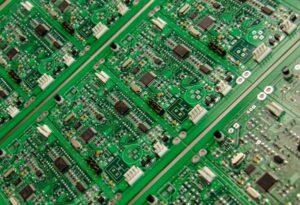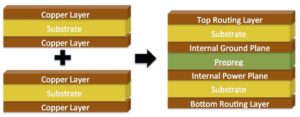Printed Circuit Boards Are Found Everywhere

PC Boards Ready to be incorporated into other products
Originally found only in devices that are obviously “electronic” in nature – computers, stereos, and the like – PCB assemblies can now be found just about everywhere. We all carry a handful of PCB assemblies in our pockets each day, such as those that are embedded in our cell phones. Countless medical, consumer, military, security and industrial products contain PCB assemblies, and often,Printed Circuit Boards Starts with Picking the Correct Substrate
When most people look at a printed circuit board, they focus on the components soldered to it. (“Look how many there are! They’re so tiny!”) But the PCB assembly process really begins with the selection of the correct bare board material, the substrate. The substrate is the material that holds the copper traces and electrical components; it is the foundation of the PCB assembly. The correct PCB substrate is determined by the end application. Different substrates have different properties that can affect the functionality of the finished product. The challenge for today’s engineer is selecting the proper substrate for the application, taking into consideration the requirements of their final product.
Common PCB Substrates
The most common type of printed circuit board material is FR4. FR4 is a fiberglass cloth material bound together with epoxy. It is rigid, durable, flame-resistant, and easy to assemble and rework. It comes in many different thicknesses, the most common being 0.062″. It can contain many copper layers; these layers are typically added in pairs.

Image courtesy of BitWeenie
FLEX PCBs
Increasingly, small devices, wearable devices, and uniquely-shaped devices are calling for a flexible PCB material. “Flex PCBs” can be made from FR4, polyimide, and other materials. These PCBs are more difficult to process, as their flexibility makes it difficult to place PCB components accurately – typically, a rigid carrier is required. However, some applications need their inherent flexibility to make the most use of limited space.
Rigid Flex” PCBs
Rigid and flexible materials can be combined to create “rigid flex” PCBs. These are more expensive and difficult to process, but they can also eliminate the need for wire harnesses and connectors in applications with very limited space.
Aluminum-based PCBs
And for those circuits that generate a lot of heat, aluminum-based PCBs may be the right solution. These PCBs consist of an aluminum base and a copper tracing layer separated by a thin, thermally conductive dielectric layer. Metal core PCBs are great for pulling heat out of high-power LEDs, MOSFETs, or other high-wattage components. However, they come at a premium price, and can be very difficult to rework.

PCB’s for your next Project
What is your next project, and what kind of PCB do you need? Our engineers can work with you to determine what substrate meets your product’s specifications. Or do you already have a board design, and are simply looking for a manufacturer? In either case, ADL will be happy to work with you to build quality PCB boards that meet your products specifications.
Contact us today!
- Use our online form to start the quotation process
- Call us: (614) 345-9040
